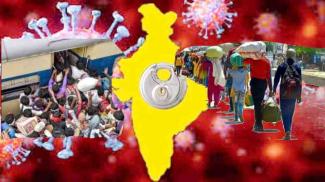
82% Say They Don’t Want to Migrate Again, Jobs Should Be Given in the Home State
95% Didn’t Get Any Governmental Help During Lockdown
Average Lockdown Financial loss per worker = Rs. 30,428
Average Lockdown Unpaid Wage per workers = Rs. 18,200
Average Loan amount borrowed by each worker during Lockdown = Rs. 24,180
CPIML conducted a survey of migrant workers who managed to reach their homes in Bihar after months of gruelling experiences of starvation, police and administrative brutalities under the lockdown in 32 states. The survey was done online, assisted at village level by party cadres, covering 29 districts of Bihar, a state which has the distinction of sending the second highest number of migrants to other states in India. The survey aimed to assess the economic conditions of migrant workers, as well as their aspirations of work in future and their expectations from the government. The survey was conducted between the first week of June and second week of July covering 7864 workers in 29 districts.
Of the total workers surveyed 4.97% were women migrant workers.
The monthly wage profile of migrants ranges from as low as Rs. 5000 to Rs 10000 per month for 47.36% of workers, and Rs. 10,000 to 15,000 for another 40.03%. Almost half of the migrant workers get monthly wages less than Rs. 10000. This explains the level of their exploitation, even in normal times.
A profile of number of dependents in family shows that 42.56% workers have to care for three to five members in the family, while another 42.87% have six to eight dependents on them.
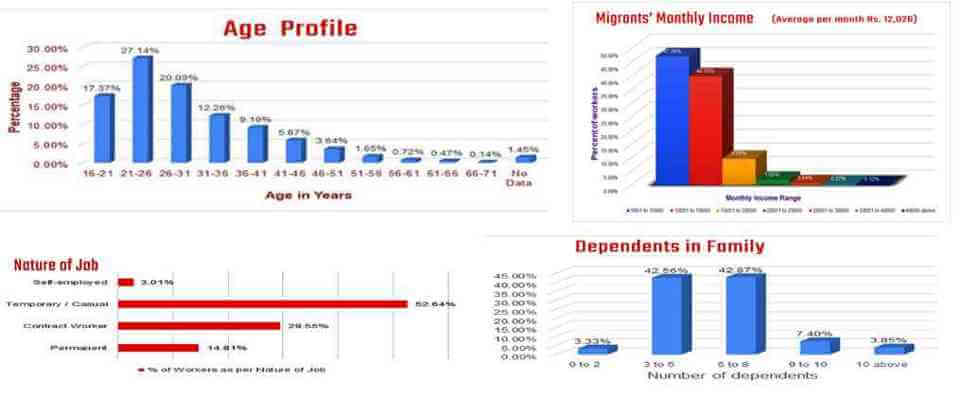
Age Profile
Surprisingly 64.5 percent of the migrant workers are aged below 30 years. The percentage of total workers below the age of 40 years is 85.95. This corresponds to the peculiar characteristic of jobs market in India where a precarious nature of work in absence of any social security and legal benefits prevails. Such a job market will certainly prefer to employ younger workforce to extract maximum profit and will do away with senior, more experienced and older workers.
A similar job market trend is also explicit if we look into the years spent as a migrant worker. There are few workers who have spent two decades or more working in the cities. 85.5% of surveyed workers have been migrants for less than or up to fifteen years, while 45% have been migrants for five years or less.
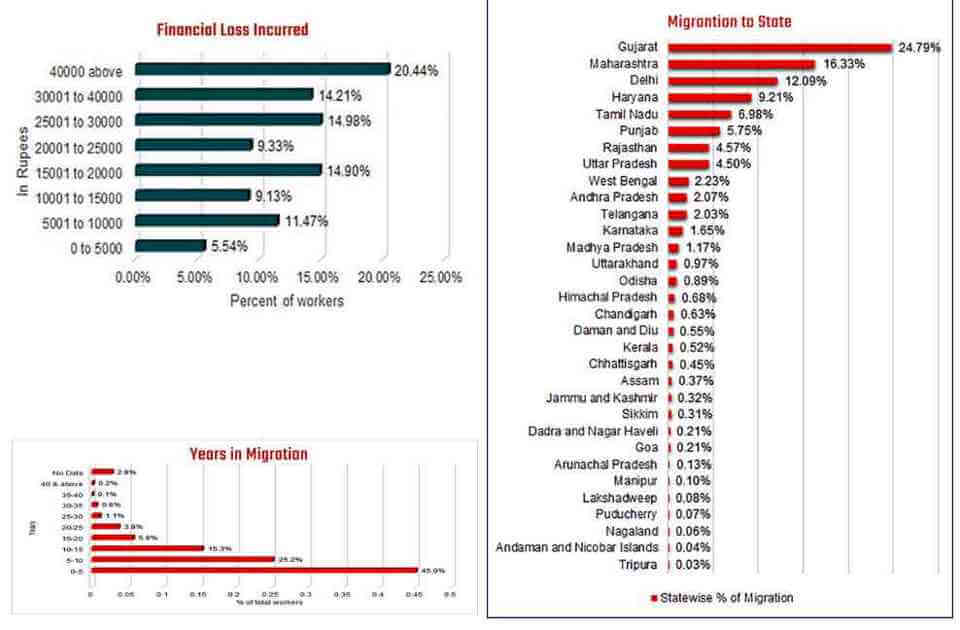
Precarious Jobs & Uncertain Future
Only 14.81% said they have jobs of a permanent nature, while 3.01 are self-employed. The rest of the workers were either temporary/casual (52.64%) or were contract workers (29.55%).
81.84% were migrants for 1-10 years and 15.44% for 11-20 years. The precarious nature of migrants’ lives and jobs was pretty evident as there were very few migrants with longer durations of stay outside Bihar. Only 2.3% of the migrant workers surveyed had worked out of Bihar for 21-30 years, and only 0.42% had worked outside Bihar for more than 30 years.
Financial Loss Under Lockdown
The total financial loss incurred during the lockdown by 7864 workers comes to Rs. 22,34,05,002 as described by the workers themselves. Based on this, the average financial loss per worker is Rs. 30,428. This figure, for a worker who earns Rs 5000 a month, amounts to six months’ wages.
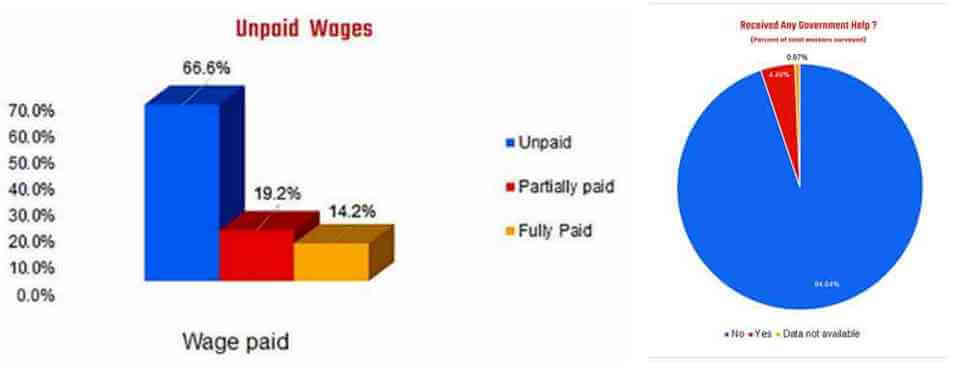
Major Migration States
Surveyed workers had returned from 32 states and Union Territories. 62.42% of them worked in four states (Gujarat 24.7%, Maharashtra 16.33%, Delhi 12.09% and Haryana 9.21%).
Unpaid Wages
The average unpaid wage after declaration of lockdown per worker is Rs. 18,200.
The majority of workers in India are migrants, with Bihar having the distinction of being the second largest source state for such workers, accounting for 14% of total migrant workforce of the country (UP tops with 25% of the country’s migrant workers). For the 7864 workers surveyed, total unpaid wages were Rs. 9,48,05,923.
As per an Economic Survey estimate, the number of total migrant workers in country is around 10 crores, which anyway seems to be an underestimate in a country with number of working population of more than 50 crores. Still if we extrapolate the average unpaid wages per worker considering 10 crores migrants (this also excludes street vendors and other informal or self employed categories), the quantum of total unpaid wages of workers comes to be Rs. 1,82,004 crores. This exceeds the actual revenue/financial component which was supposed to be disbursed by the central government through the much hyped Rs. 20 lakh crore ‘Lockdown Relief Package’ that included the Garib Kalyan Yojana scheme. These schemes are little more than propaganda, that only benefit big and small corporations, not workers.
Immense economic hardships and pains were inflicted by the lockdown. Non-payment of wages was one aspect, and there are other financial constraints migrants had to face. The above figures are based on the actual amount told by the workers which in turn is according to the actual wage they are paid by the employers. For most of the unorganised sector, informal and contract workers, actual in-pocket wages are far less than the statutory minimum wage rate – usually they are paid less than half to two third of the statutory rate. If one considers the loss of unpaid wages during lockdown according to government approved rate then it amounts to more than double this figure!
Moreover, this is only about unpaid wages. The financial losses accrued due to the loss of job during last 4-5 months of lockdown and pandemic, if calculated methodically, will be a huge sum which the government owes to the workers. This is why Left parties and trade unions have demanded payment of Rs. 7,500 per month as pandemic allowance.
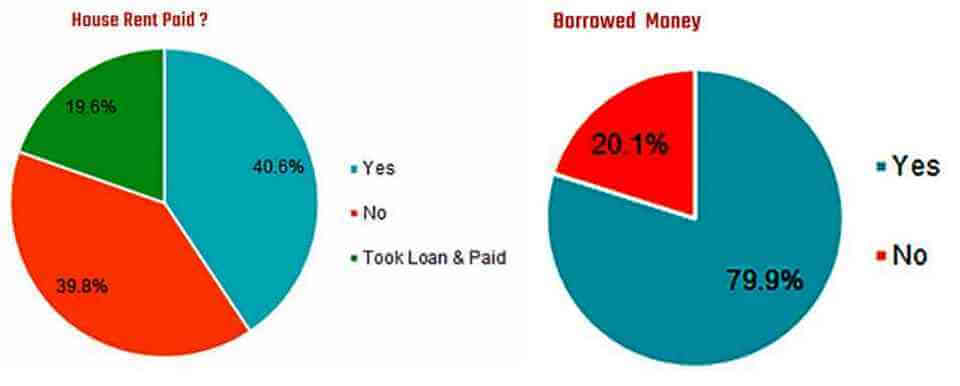
Had to Take Loans for Food, Rent and Travel
With no hard cash in hand, and left to fend for themselves, stranded workers in cities had to borrow money for their survival. And they also had to pay for the rent of their rooms/lodging. 59.4% workers could not pay their rent and had to face additional pressure which led 19.6% of them to borrow more money only to pay rents.
79.9% of the workers surveyed had to take loans (from private sources) for immediate needs after the lockdown was declared. In our survey, the total absolute loan amount for 7864 workers (20.1% did not take loan) comes to be Rs. 19,01,58,594. The average loan amount borrowed by each worker, then, comes to be Rs. 24,180 (for a worker earning Rs 5000 monthly, this would be around 5 months’ wages). And for ten crore migrants this has to be Rs. 2,41,800 crores: a bigger amount than the loss incurred in unpaid wages. This underlines the extent of underpayment existing during pre-pandemic/lockdown time, showing us that the workers’ wages are not enough even for their day to day survival and there is no scope of saving money for a rainy day, let alone towards their future.
Migrant workers had been forced to take loans, the total sum of which is much higher than any government declared relief plan. This exposes the unwillingness of the Modi government to acknowledge the actual harm done to the migrants and general public due to the lockdown, and safeguard them from such harm. The calamitous repercussions of this policy bankruptcy being faced by people are much bigger than the damage being experienced due to the pandemic itself.
No Proof of Identity
Only 0.37% workers have voter I-card in cities of migration and 0.85% have ration cards. It is obvious that any governmental support during lockdown was inaccessible to them in absence of valid identity proofs. Only 4.49 percent of surveyed workers got some kind of help from any government agency while 95% survived on their own without any support.
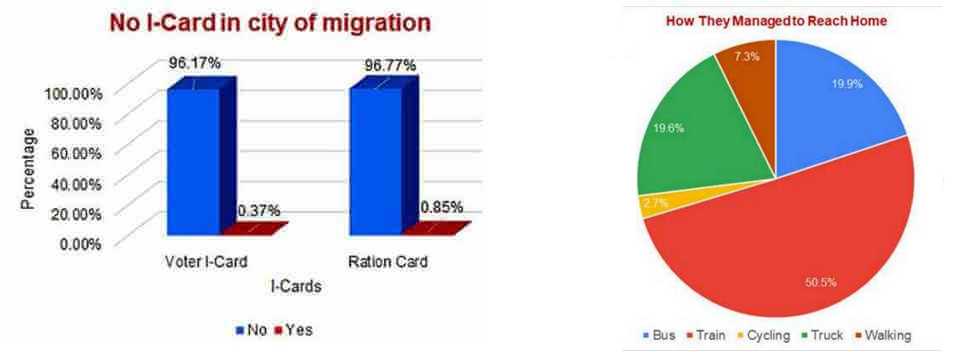
Travel Back Home – 7.4% Walked and 3% Came on Cycles
7.3% stranded migrants had no means to get back to home except walking hundreds of kilometres. This cruelty had taken hundreds of lives on highways and railway tracks, and even inside Shramik Special Trains. 2.7% cycled from distant states to their homes. 19.6% boarded on trucks for their travel for which they had to hide to avoid the predatory surveillance of police in various states. An almost similar number - 19.9% - managed to board buses, while 50.5% got back home on trains. The train journeys were no less tortuous, with trains being diverted, delayed, and even “lost”, without food and water arrangements en route.
In spite of loud propaganda by the governments and railways, only 8.5% of workers surveyed could get home on governmental support. 2.2% said their employers managed travel expenses. 89.3% had to manage on their own; of them 54.7% had to borrow money for travel expenses.
Among workers who either walked or came on bicycles, 69.67% were under the age group of 15-30 years, and 25.71% under 31-45 years. But there were 4.53% above 45 years of age who also had to walk or cycle back home under the lockdown.
Quarantine Centres in Home State
There was no relief from their ordeal even after returning to their villages. The workers had to be quarantined in assigned places which lacked basic facilities. 30.8% surveyed said that at those centres they faced overcrowding, lack of water and sanitation facilities, lack of soap, sanitiser, mosquito repellents/nets, lack of facilities for testing and medical care.
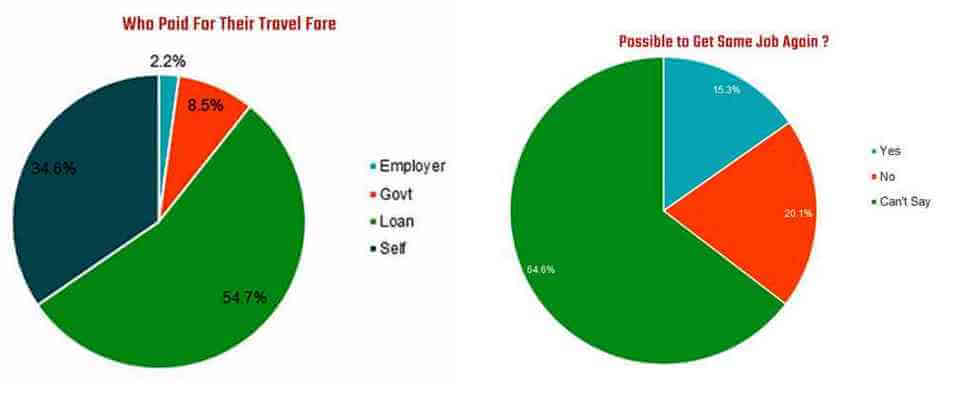
Can They Stay Back in Villages?
Almost 90% of migrants who work in cities have no means of income from land in villages. Either they are landless or their lands are not productive owing to small land size. Only 9.7% of migrants have some additional income from land/agriculture. So workers and their households face very grim prospects if they fail to get work in their home state. Only 1.5% of workers who returned to their village could get some kind of job in the village for sustenance while 98.5% are now idle without any job or income.
The additional allocation declared for MNREGA is highly inadequate. The continuing low daily wage rates (for the arduous manual labour that MNREGA work involves) is bound to force workers back to the cities for survival in spite of their unwillingness to go back to the same place that they had to flee without any governmental support. Forced by circumstances imposed by the government, such a “return to the cities” is nothing but modern slavery. We have heard reports of special trains being launched to “bring back” workers to cities. We also saw how some state governments tried to cancel trains meant to transport stranded workers back to their home states during the lockdown. Workers are aspiring for something very different.
Only 15.3% of them think that it is possible for them to get job back at the same place which they had left. 20.1% are sure of not getting the same job again, while little less than two third of them, 64.6% are not able to say anything with confidence. Thus 84.7% are not confident of getting their job back.
Do They Want to Migrate Again
No. For 72.1% choosing to go back to the city is not a better option, out of which 26.5% are determined NOT to go back again and 45.6% say they cannot say if they should migrate again.
82% of surveyed workers do not want to migrate to other states They want a job in their home state itself. Out of these, 18% have firmly demanded that they should get job in their own place, their village or town.
Only 18% are willing to go outside the home state, but during informal discussions with surveyors most of these expressed a desire to work in the home state if they got a decent job.
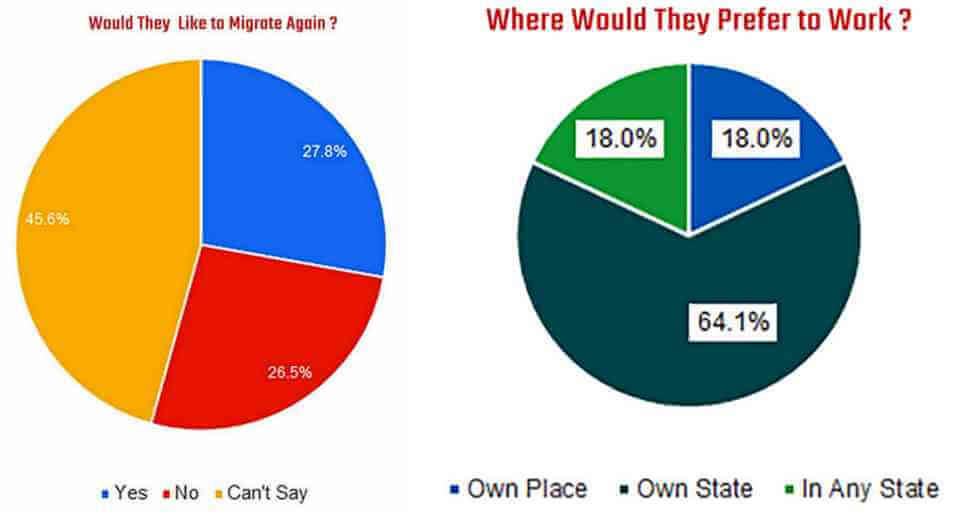
What do the findings of the survey indicate for the future of this segment of workers?
The survey underlines the urgent need to challenge and change the exploitative conditions of work in India, where migrant workers serve as a captive, underpaid workforce.
What is needed, as we indicated in the “Notes on Migrant Workers: Key Issues and Urgent Tasks” published in the July issue of Liberation, is “revival and reopening of sick and closed industries, formation of a new chain of agro-based and other labour-intensive small and medium units and big factories or service chains with better employment and income prospects” in the home states, and “in the short-term, this must be complemented by an improved and more effective NREGA framework (with increased duration and scope for work and better wages), launching of employment guarantee act for the urban unemployed, massive expansion in public works (with building of government hospitals and schools and colleges as the main priority), provision of unemployment benefits/allowance and more effective entrepreneurial assistance to promote self-employment.”
Liberation Archive
- 2001-2010
-
2011-2020
- 2011
- 2012
- 2013
- 2014
- 2015
- 2016
- 2017
- 2018
- 2019
-
2020
- Liberation, JANUARY 2020
- Liberation, FEBRUARY 2020
- Liberation, MARCH 2020
- Liberation, APRIL 2020
- Liberation, MAY-JUNE 2020
- Liberation, JULY 2020
-
Liberation, AUGUST 2020
- The Pledge of Independence Day 2020: Freedom from Fascism
- The Pledge of July 28
- The Vikas Dubey Phenomenon: Criminal-Police-Politician Nexus and Encounter Raj Imperil the Rule of Law in Uttar Pradesh
- Saffronised Slashing of CBSE Curriculum
- Remembering Pranab Da and the Durgapur 'Steel Melting Shop'
- Political Crisis in Rajasthan: Alarming Signals for Indian Democracy
- One Year Of Kashmir Caged
- Kashmir Domicile Law: Incremental Dispossession, Statelessness and Displacement
- Ladakh: One year after UT Status
- Kashmir Since August 5, 2019
- Delhi Riots Revisited
- The Communal is Anti-National Destroy It Root And Branch
- A Post-Lockdown Online Survey of Migrant Workers in Bihar
- Sanitation Workers' Struggle During The Pandemic
- Three Agrarian Ordinances: Undermine State Autonomy and Harmful to Farmers
- From Feudal Mahajans To The "Bandhan" Of Micro Finance Institutions
- The Tyranny of Rent
- EIA Under Attack Environmentalists Branded Terrorists
- 3 Day Coal Workers' Strike Against Privatization
- Stand with the Affected People of Assam and Bihar
- Obituary
- Release All Political Prisoners
- Liberation, SEPTEMBER 2020
- Liberation, OCTOBER 2020
- Liberation, NOVEMBER 2020
- Liberation, DECEMBER 2020
- 2021-2030
Charu Bhawan, U-90, Shakarpur, Delhi 110092
Phone: +91-11-42785864 | Fax:+91-11-42785864 | +91 9717274961
E-mail: info@cpiml.org







